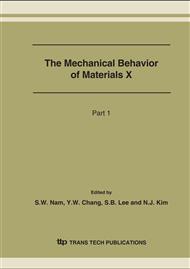p.315
p.319
p.323
p.327
p.331
p.335
p.339
p.343
p.347
Fatigue Fracture Behavior Depending on Stacking Sequences in Quasi-Isotropic CFRP Laminates after Lateral Impact
Abstract:
A series of fatigue tests has been conducted to estimate the fracture behavior depending on stacking sequences in quasi-isotropic CFRP laminates. Strips of laminate with four different directions were cut out from the same CFRP plate to prepare the specimens with the four kinds of stacking sequences. Prior to fatigue test, the specimens were impacted with lateral load in order to simulate the damage induced by the fallen tools. During the fatigue tests, the damage developed in the specimen was detected by non-destructive techniques using a scanning acoustic microscope (SAM) and a replicating method. Stacking sequences exerted an influence on fracture behavior of laminate specimens, i.e. the stacking position of the zero degree layers, in which fiber direction was parallel to the loading axis, played an important role in the fracture process. When the zero degree layers are located at the specimen surface, no remarkable damage propagation was observed from the surface. On the other hand, when the zero degree layers are located in the middle of laminates, the damage in the surface layer was found in the fatigue process. Not only the degradation of the equivalent elastic modulus was seen in all specimens, but also the degradation curve varied with the stacking sequences.
Info:
Periodical:
Pages:
331-334
Citation:
Online since:
August 2007
Authors:
Price:
Сopyright:
© 2007 Trans Tech Publications Ltd. All Rights Reserved
Share:
Citation:


